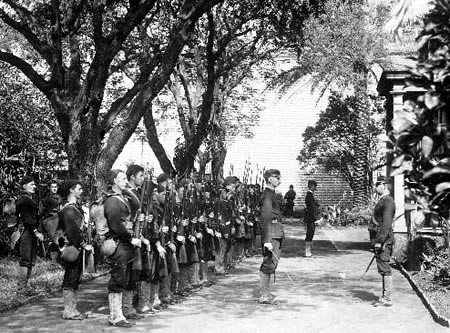 |
| Attempted U.S. Takeover of Hawaii |
The U.S. political and economic agenda to dominate Hawaii accelerated in 1867–1868. Due to the high tariffs levied by the United States on imported Hawaiian sugar, both countries sought closer economic ties. Two options were being considered to improve relations.
On an official level, negotiations for a Reciprocity Treaty were under way between Charles Coffin Harris, the envoy representing King Kamehameha V
Yet, a simultaneous push for annexation was also gaining support among disgruntled U.S. residents. One catalyst that contributed to the worsening relations was the navy’s decision to dispatch the USS Lackawanna to Hawaii, where ship and crew were under orders to remain permanently.
  |
Screening this deployment of troops as a response to a threat of French aggression, the United States insisted that the ship was there only to protect U.S. interests and its citizens. Arriving on 9 February 1867, the Lackawanna anchored in Honolulu Harbor
If the U.S. had been sensitive to the fragile relations between the two countries, the navy would have no doubt limited the duration of the orders, or at least sent another captain. William Reynolds
His return to Honolulu at the helm of a fully manned vessel of war with instructions to remain there indefinitely was cause for concern, especially since many resident Americans as well as the administration of President Andrew Johnson
In early 1868, George W. Lendeveg disclosed that a conspiracy to take over Hawaii was in the works. As captain’s clerk, Lendeveg was privy to classified documents as well as the private writings and personal correspondence of Reynolds.
Motivated by the need to find a financial solution to his own personal problems, Lendeveg broke his oath of allegiance to the U.S. Navy when he drafted a letter to the king in which he promised to furnish information that would prove Reynolds was plotting against the monarch. Lendeveg pledged loyalty to Kamehameha and offered his services as a spy to uncover the machinations of the conspirators; however, he made it clear that he expected to be rewarded for his role in saving the kingdom.
Alarmed at the extent of the conspiratorial network, Lendeveg counseled the king that even his most intimate advisors were not to be trusted and insisted on delivering the evidence in person. Since the future of the nation might be at stake, a ministerial-level interview with Attorney General Stephen H. Phillips was arranged.
Unsatisfied that his tale of subterfuge had been adequately addressed at this meeting with the king’s intermediaries, Lendeveg wrote another letter warning that the crisis was at hand. Arguing that urgency was paramount if the kingdom was to be saved, Lendeveg revealed the names of those who had been beguiled by Reynolds and were now recommending revolution and annexation by the United States.
After evaluating the evidence Lendeveg had stolen from Captain Reynolds, Charles de Varigny, the minister of foreign affairs, informed Washington of Lendeveg’s treasonous activities and forwarded copies of the two seditious letters to Secretary of State William Seward.
Even though the Reciprocity Treaty was ratified by the Hawaiian Legislature, it was rejected by the U.S. Senate. The setback halted all progress on a closer economic union at this time. What about the threat of annexation? Hawaii had failed to gain the much-coveted elimination of tariffs on its sugar exports, but its diplomatic maneuvering preserved the nation’s independence.
Official disclosure of Lendeveg’s treachery made the conspiracy to annex the islands public knowledge, and this prevented Reynolds and the U.S. government from moving unilaterally. On 6 May 1868, the Lackawanna departed Honolulu and sailed for San Francisco. Once there, George Lendeveg was court-martialed and sentenced to fines and ten years’ hard labor. The sentence was subsequently reduced by Rear Admiral H. K. Thatcher and later commuted by the attorney general.
Theft of private correspondences and official documents, which may have exposed a U.S.backed plot to incite revolution in a sovereign state, and the handing over of those documents to a foreign government are treasonous activities, yet Lendeveg’s punishment for these actions was expunged. By exonerating Lendeveg, the United States cleansed itself of all involvement in a conspiracy that, now, officially never existed.